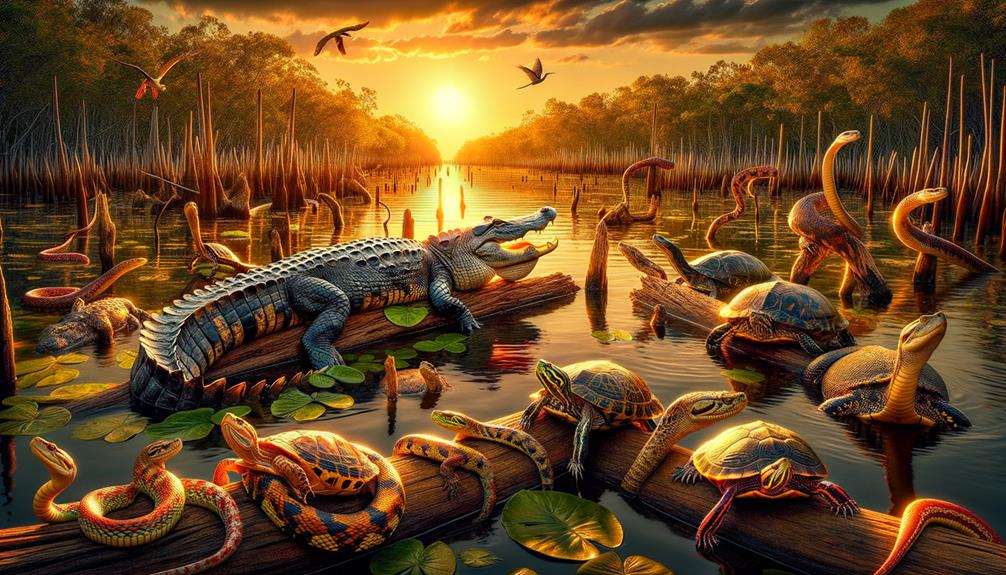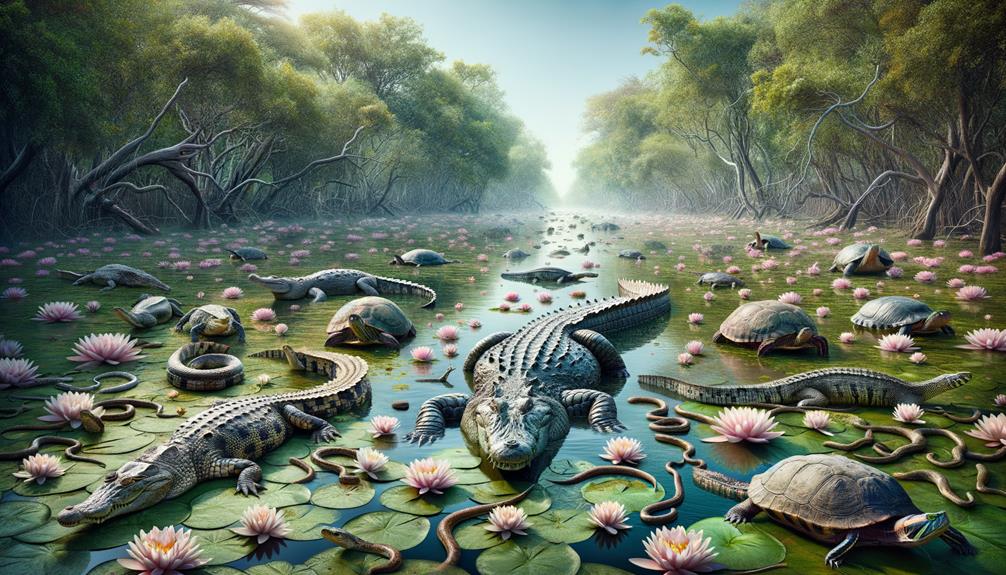In the heart of South America lies the Pantanal, a vast and vibrant wetland teeming with life. River otters frolic alongside jaguars, while capybaras graze peacefully nearby. Above, the vibrant azure hyacinth macaw and elegant jabiru stork add splashes of color to the landscape. The green anaconda and yacare caiman patrol the water's edge, sharing space with the elusive maned wolf on land. Piranhas dart through the murky waters. During seasonal floods, these wetlands transform into lush nurseries for countless species. The Pantanal is a treasure trove of biodiversity, and there's still much to learn about this remarkable ecosystem.
Key Takeaways
The Pantanal is home to the world's largest rodent, the capybara, which can weigh up to 175 pounds. This wetland boasts the largest population of jaguars, making them the top predators in the region. The area is a birdwatcher's paradise, with over 650 species, including the iconic Jabiru stork and the vibrant Hyacinth macaw. The Yacare caiman thrives in the Pantanal, with a staggering 10 million individuals calling this wetland home. The seasonal flooding of the Pantanal creates ideal nurseries for aquatic species like the pirarucu and giant catfish, allowing them to flourish in this unique environment.
Mammals of the Pantanal
In the Pantanal's vast, watery expanse, you'll find an incredible variety of mammals. The capybara, the world's largest rodent, is a remarkable sight as it ambles through the wetlands, weighing up to 175 lbs. The jaguar, a formidable predator, thrives in this habitat due to the abundant prey and accessible waterways, with the Pantanal boasting the largest population of these majestic creatures.
The giant river otter, the largest otter species globally, dominates the Pantanal's rivers and wetlands with an estimated 3,500 individuals. Social creatures, they're often seen in family groups, playing and hunting together.
The maned wolf, South America's largest canid, stands tall at three feet, perfectly adapted to navigate the tall grasses. Its unique appearance and elusive nature make it a fascinating yet rare sight.
The marsh deer, threatened by habitat loss, finds refuge in the Pantanal. This region serves as a critical refuge for one of the largest remaining populations of this graceful ungulate, highlighting the Pantanal's pivotal role in preserving diverse mammal species in a threatened habitat.
Bird Species
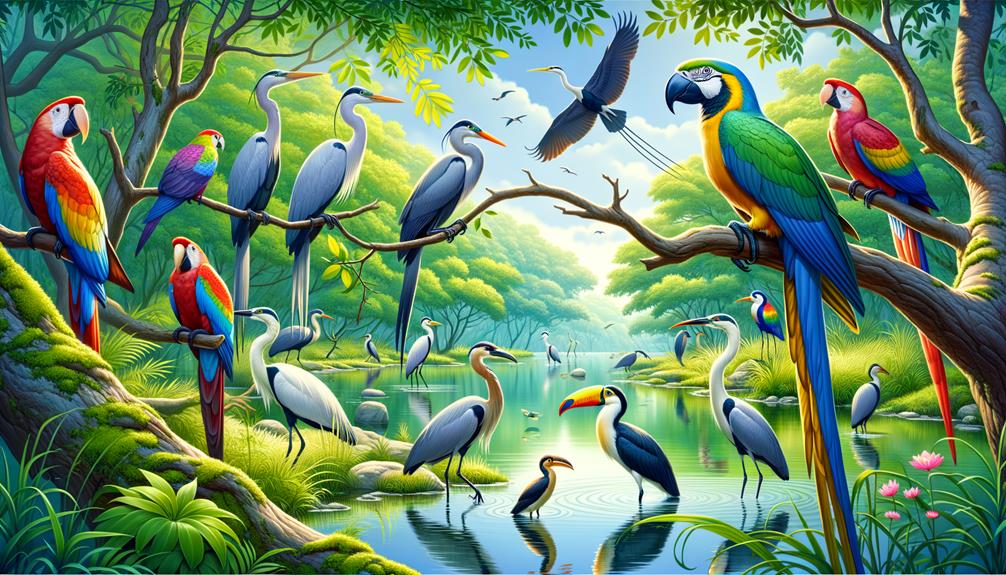
The skies of the Pantanal come alive with an astonishing 650 bird species, offering a unique spectacle of avian diversity. Every glance towards the wetland reveals the vibrant life of storks, herons, egrets, and spoonbills. Among these, the Jabiru stork stands out as the largest flying bird in the Americas, thriving in this rich habitat.
The Pantanal is not just a sanctuary for resident birds but also a critical stopover for migratory birds traveling between North and South America. The seasonal flooding creates ideal breeding and feeding grounds, making this wetland a hub of avian activity. It's crucial to protect these habitats, ensuring the long-term survival of this magnificent wildlife.
Bird Species | Unique Attributes
— | —
Jabiru Stork | Largest flying bird in the Americas
Hyacinth Macaw | Bright blue plumage, relies on palm nuts
Toco Toucan | Large colorful bill, iconic in the tropical forest
Great Egret | Elegant white plumage, common in wetlands
Experiencing the Pantanal's avian diversity is like stepping into a vibrant ecosystem, where each bird contributes to the rich tapestry of aquatic life and wildlife that makes this wetland so enchanting.
Reptiles and Amphibians
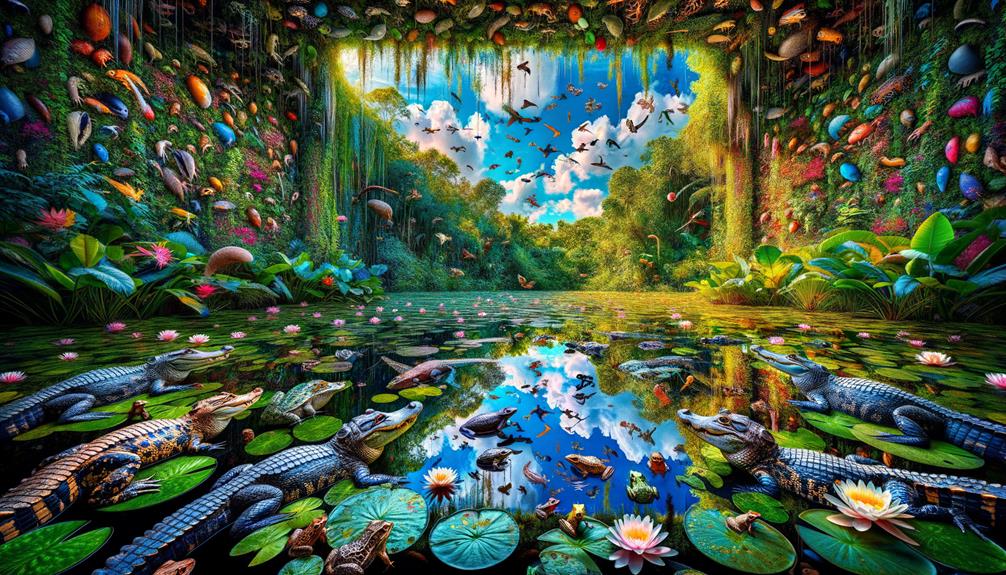
In the Pantanal's lush wetlands, a stunning array of reptiles and amphibians thrive. This unique habitat is home to an astonishing biodiversity. From the massive green anacondas, the world's largest snakes, to the highest concentration of crocodilian species on Earth, the Pantanal showcases nature's incredible design.
The critically endangered Yacare caiman has made this wetland its home, with a remarkable population of over 10 million individuals. As a vital part of the ecosystem, it ensures balance and stability. The Pantanal tree frog, which grows up to 5 inches long, finds ideal breeding grounds in these wetlands, playing a crucial role in the vibrant tapestry of life.
Freshwater turtles, such as the giant South American river turtle, are abundant in the Pantanal's rivers and lakes. These creatures are vital for the ecosystem, contributing to its health and resilience. However, this diverse wildlife faces threats from habitat loss, pollution, and illegal trade. To protect these endangered species and preserve the Pantanal's rich biodiversity, conservation efforts are crucial. By safeguarding this incredible habitat, we ensure that future generations can experience the wild freedom of the Pantanal's reptiles and amphibians.
Aquatic Life
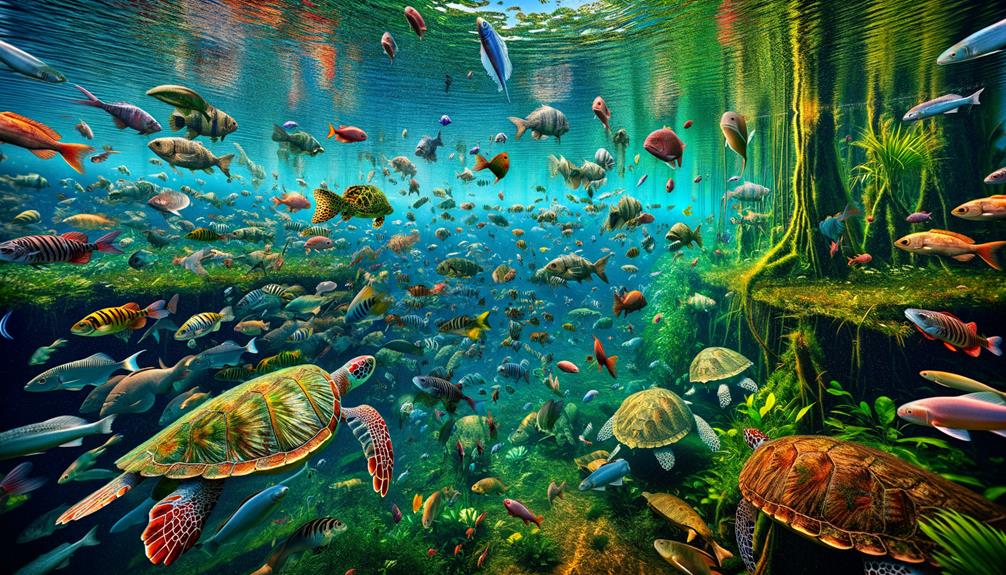
The Pantanal's aquatic life is a world of its own, hidden beneath the water's surface. With over 260 species of fish, the region's waters are teeming with life. The piranha, pirarucu – the world's largest scaled freshwater fish – and the elusive giant catfish are just a few of the notable inhabitants.
The seasonal flooding of the Pantanal transforms the wetland into a nutrient-rich haven, creating ideal conditions for aquatic life to thrive. This dynamic habitat supports a high level of biodiversity, providing a sanctuary for endangered species like the giant river otter. However, the Pantanal's aquatic ecosystems are fragile and face threats from pollution, chemical runoff, and mining activities, which disrupt the delicate balance. Overfishing also endangers key species.
Some significant aquatic inhabitants include:
| Species | Notable Feature | Threats |
|---|---|---|
| Piranha | Sharp teeth and aggressive behavior | Overfishing |
| Pirarucu | Largest scaled freshwater fish | Overfishing, pollution |
| Giant Catfish | Enormous size and bottom-dwelling habitat | Habitat loss, pollution |
The Pantanal's aquatic life is a vital part of its ecosystem, and it's essential we take action to preserve its beauty and diversity.
Flora and Fauna Interaction
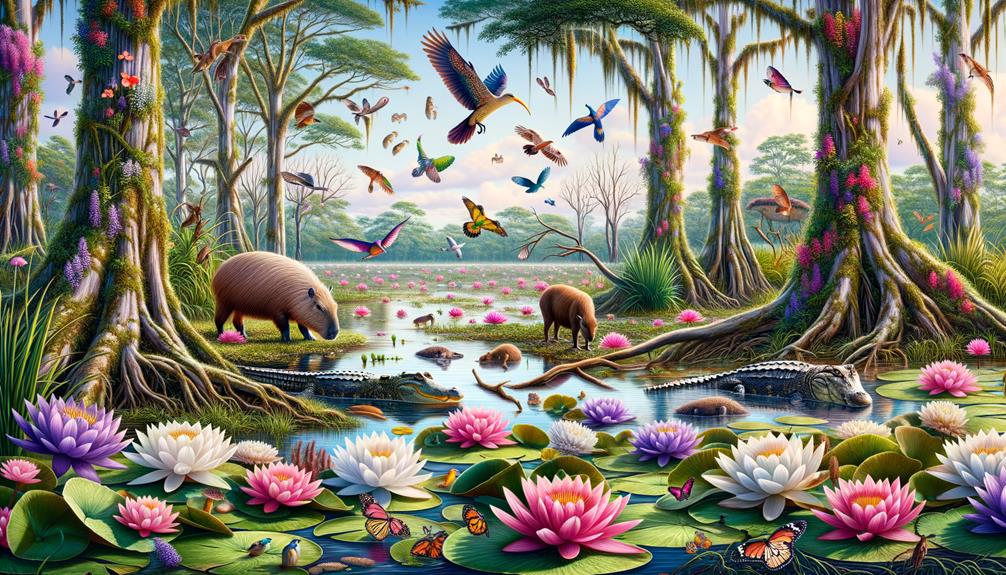
In the Pantanal, a delicate balance exists between flora and fauna, each playing a vital role in sustaining this thriving ecosystem. The diverse native vegetation, ranging from aquatic plants to gallery forests, sets the stage for this biologically rich region. Seasonal flooding brings new life, allowing fish to flourish and transforming the wetlands into nurseries for countless aquatic species. This cyclical transformation fosters habitat diversity, crucial for the Pantanal's intricate web of life.
Keystone species, such as the apple snail, play a vital role in nutrient cycling and sustaining ecological balance, particularly during low-oxygen periods. The high density of crocodilians, like the yacare caiman, showcases another layer of interaction. They regulate fish and small mammal populations, while also becoming prey for apex predators like the jaguar, thereby maintaining a dynamic equilibrium.
Migratory birds, including storks, herons, and egrets, flock to these wetlands, drawn by the seasonal abundance. They nest and feed, enriching the ecosystem with their presence. Every species, from the smallest snail to the mighty jaguar, contributes to this intricate tapestry, demonstrating that the Pantanal's health depends on the seamless interplay between its flora and fauna.
Frequently Asked Questions
Who Are the Indigenous People of Pantanal?
The Pantanal's more than just a wetland – it's home to the Kadiwéu, Guató, and Terena peoples, who have lived there for centuries. These indigenous communities rely on the land's resources and have a deep connection to the area.
Does Anyone Live in the Pantanal?
Around 260,000 people call the Pantanal home, including indigenous communities and ranchers who have learned to coexist with the land. Their livelihoods depend on traditional practices, cattle ranching, agriculture, fishing, and ecotourism.
What Is the Biodiversity of the Pantanal?
The Pantanal is a hotbed of biodiversity, teeming with life. This vast wetland is home to an incredible array of species, including jaguars, caimans, capybaras, and over 650 bird species. For nature enthusiasts, the Pantanal is a dream come true, offering unparalleled opportunities to explore and discover the natural world.
Why Is the Pantanal Wetland Important?
The Pantanal wetland is vital because it's a habitat for a staggering array of wildlife, helps regulate the climate, and purifies water. It's a natural treasure that gives countless species the freedom to thrive, which in turn enriches the health of our planet.


